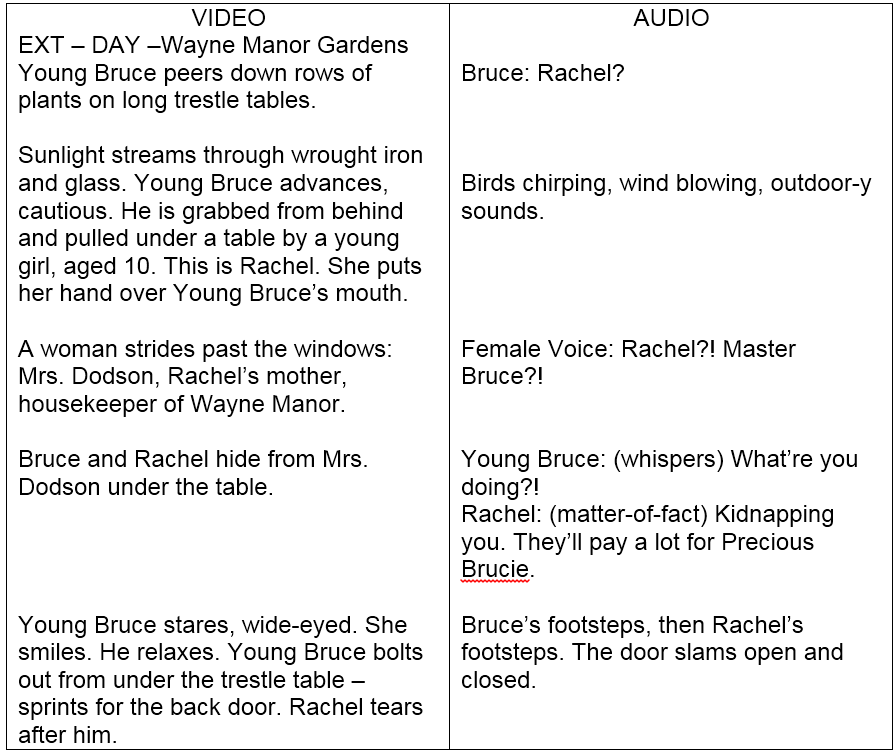By John Oyster | AV Support Analyst
 When it comes to creating a polished video project, script formatting is a key component that often goes overlooked. The script is your blueprint for the entire video; it tells the photographer what they need to shoot, it tells the talent what they need to be doing, and it tells the editor how to piece it all together. Therefore, it is critical that your script be formatted in a clean and concise way. Luckily, professionals in the industry thought of this long ago. As a result of their endeavors, there are two different ways to format a script; the first is primarily used by film and television (narrative), and the second is a two-column audio/video (AV) script.
When it comes to creating a polished video project, script formatting is a key component that often goes overlooked. The script is your blueprint for the entire video; it tells the photographer what they need to shoot, it tells the talent what they need to be doing, and it tells the editor how to piece it all together. Therefore, it is critical that your script be formatted in a clean and concise way. Luckily, professionals in the industry thought of this long ago. As a result of their endeavors, there are two different ways to format a script; the first is primarily used by film and television (narrative), and the second is a two-column audio/video (AV) script.
The most common format to write a script is what I’ll call the “narrative” format. The narrative format is laid out this way to make it easy to read, and to ensure planning the shoot is as easy as possible. For example, each scene is numbered so the producers, directors, etc. can have a final count of how many scenes there are in the script. Each scene begins with whether it takes place outside (EXT) or inside (INT) and whether its daytime (DAY) or nighttime (NIGHT), so scenes can be easily placed into groups and shot in the most efficient manner possible. Directly below the scene heading, we find a description of what we can see and/or hear (with key words, actions, and props CAPITALIZED), and dialogue is indented inside, with the character’s name centered above and capitalized. A fun fact about the narrative style: these scripts are formatted to be on average one minute of screen-time per page. As a result, a 120-page script would roughly translate to a two-hour film or video.
For reference, here is a sample from the beginning of Christopher Nolan’s film Batman Begins, written by David Goyer:
 The second script format, the two-column AV script, is likely the most pertinent format for our clients to use. A far simpler format than the narrative script, the two-column AV contains…two columns! One column notes visuals (scenery, props, actions, etc.), and one notes what you hear (dialogue, music, effects, etc.). Below, I’ve re-written the first scene from Batman Begins (above) as a two-column script:
The second script format, the two-column AV script, is likely the most pertinent format for our clients to use. A far simpler format than the narrative script, the two-column AV contains…two columns! One column notes visuals (scenery, props, actions, etc.), and one notes what you hear (dialogue, music, effects, etc.). Below, I’ve re-written the first scene from Batman Begins (above) as a two-column script:
The two column script can be as detailed as you would like it, or it can be as broad as you want; it is a much more free-flowing script, as opposed to the narrative format, which is very strict in format.
How you decide to format your script is entirely up to you. For first-time clients, or clients who are new to writing scripts, I would recommend using the two-column format. It’s much less cumbersome to format; you don’t have to worry about indenting or buying software to format it for you. I would recommend using the narrative format if you are more experienced with writing, and if your project is more narrative-centered. For anyone interested in writing in the narrative format, there is a great online tool called Celtx (www.celtx.com) that can format scripts for you!
Good luck, and happy writing!
